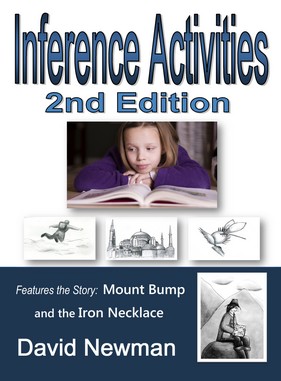Teaching Inferencing
Teaching inferencing to students with language impairment can be important,
because they may find it difficult to generate implied meaning from text independently.
Brown and Yule define inference skill as 'that process which the bearer
or reader must go through to get from the literal meaning of what is written
to what the writer intended to convey.'
Inference - an example
An inference is a prediction or deduction about something in written text
often to do with what the character may see, hear, smell, taste or feel.
An inference contrasts sharply with mere observation, or literal language.
For instance, an observation may be... 'It was a hot day and Billy sweated, so
he stripped to his shorts to get cool.'
An inference would be more like... 'Billy stood in the shade of a tree, that helped
beat back some of the heat. He changed into his shorts and put sunscreen on his skin.'
The observation presents only the facts. We know it's
a hot day because it states, 'it was a hot day and Billy sweated.'
In the abover inference example, there is nothing stated explicitly about it being a hot day.
But the reader can infer that it's a hot day by the information
presented, such as 'the shade of the tree beating back the heat; and Billy changed into his
shorts and applied sunscreen.' All of the language strongly suggests that it is a hot day.
Inference can be a difficult skill for children with language impairment to
learn. Inference tends to rely on having good word and world knowledge - a solid
vocabulary knowledge, and an extensive semantic word knowledge network. We know that children with language impairment
often have impoverished vocabularies, which can impact on their ability to understand
information in text that is not explicitly stated.
Teaching Inference
So an important question is, what is the best method of teaching inference to children with language difficulty?
Apart from generally improving a student's vocabulary and world knowledge,
a good way to improve inference skills is to ask prediction questions. The student could
read a passage from a book and then asked what may happen next and why.
For a more in depth description of inferencing please follow this
link to free inferencing activities. There are several free adobe downloads, that feature teaching inferencing exercises for 7 - 11 year old students.
Teaching Inferencing using an Illustration

Here we have a rather dangerous
looking character.
How do we know he's dangerous?
Well, anybody who has electric sparks shooting from his
fingertips, has eyes hidden by deepening brows and
is decked out in flowing robes, complete with arcane symbols no less, is not someone
I'd be pleased to tangle with.
Some of the information we can infer from this illustration is that the character is probably
a wizard of some kind, has supernatural powers, and is possibly from a sword and fantasy
story.
This image has a large amount of information that can be surmised, or inferred. Let's tease
out some of those details.
1) He's not an accountant, probably.
2) He doesn't teach at Hogwarts.
3) He's got a wicked temper.
4) He's not the type to take in the washing...
5) He's handy to have around when dragons come a hunting.
Perhaps the best method of teaching inferencing to your students is to pepper them
with standard who, what, why, where, and when questions.
Some example questions...
1) Who is this man?
2) Why does he have sparks coming out of his fingertips?
3) What's his PROBLEM?
4) Where is he?
5) When did this happen?
The beauty about the who, what, where, when, and why series of questions is that there is no
limit to the questions you can generate, and the answers students can provide.
Possible reasons why students have difficulty with inference
Students may lack experience in answering inference type questions because of their teachers' inclination to focus on literal questions in the classroom, and not focus on teaching inferencing. Students may have problems employing background knowledge of a subject, and fail to link information.
Students may have difficulty decoding, and are therefore not able to devote mental resources to understanding and inferring a text's deeper meaning.
Students may focus on irrelevant information in the text and miss the text's deeper meaning, making accurate inferencing very difficult.
Students may have poor organisational skills and therefore overload their working memory capacity, which results in failure to properly comprehend text.
Students may have poor background knowledge and impoverished vocabularies, and may lack flexibility in thinking skills.
Of course inference skill does not exist in an abstract vacuum. Inability to inference well in school-age students is directly linked to reading comprehension failure, and language difficulties.For more information about inference and its relationship to reading comprehension I recommend you visit these pages: vocabulary comprehension, and vocabulary and context.
For an example of language therapy targeting inference, please visit the language theraoy inference page.
Inference Activities 2nd Edition
If you would like to learn more about inference activities click on the cover image to the Inference Activities 2nd Edition sales page.
References
Brown, G., & Yule, G. (1983) Discourse Analysis, New York: Cambridge University Press
DeKemel, K.P. (2003) Intervention in Language Arts: A Practical Guide for Speech-Language Pathologists. Butterworth-Heinemann.
Kaderavek, J.N. (2011) Language Disorders in Children: Fundamental Concepts of Assessment and Intervention, Allyn & Bacon
Kaderavek, J & Justice, L.M. (2002) Shared Storybook Reading as an Intervention Context: Practices and Potential Pitfalls. American Journal of Speech-Language Pathology, Vol 11. 395-406.
Paul, R. (2006) Language Disoders form Infancy through Adolescence. Assessment and Intervention. Mosby
Wallach, G.P. (2008) Language Intervention for School-Age Students: Setting Goals for Academic Success. Mosby Elsevier
Wagner, R.K. Muse, A.E. & Tannenbaum, K.R. (2007) Vocabulary Acquisition: Implications for Reading Comprehension. The Guilford Press
Content Updated 09/17
Also, please sign up for the Language Dispatch newsletter. Thenewsletter provides essential monthly language intervention tips, techniques and information.
The information provided in the monthly newsletters is ideally suited to be used by speech-language pathologists, teachers and parents of language impaired students.
Once you've signed up to the Language Dispatch you'll also receive a new free Idioms ebook, On Cloud Nine.
The On Cloud Nine Program features 100 context based scenarios, and a multiple choice format to effectively teach this difficult figurative language concept.
The program is very easy to use and is yours free, once you've signed up to the Language Dispatch. The program is available as an Adobe pdf download.

Return from Teaching Inferencing to Speechlanguage-Resources Homepage




